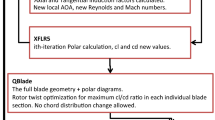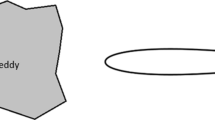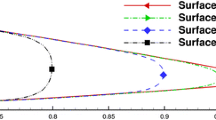Abstract
This study proposes a criterion for evaluating the turbulent boundary layer displacement thickness when predicting airfoil trailing-edge noise with semi-empirical methods. The boundary layer integral parameter is usually employed as the typical turbulence length-scale in the classic NASA-BPM semi-empirical airfoil self-noise prediction model and its variations. Although the semi-empirical noise prediction methods have been, in theory, superseded by more complex and demanding simplified-theoretical methods, they arguably remain the most suitable methods for noise investigation during the preliminary design phase of airfoils and wind turbine blades. The purpose of the criterion discussed is to limit the adverse impact of the uncertainty associated with the scaling parameter into the overall intrinsic quality of the semi-empirical noise prediction method. The criterion may be then employed, along with computational efficiency, to sort out methods for the task of feeding the popular BPM noise prediction model and its variations. As an illustration of the application of the proposed criterion, the performance of CFD-RANS and XFoil codes are examined and compared with experimental data from turbulent, incompressible flow available from the literature in the range \(5.0 \times 10^{5} < \text{Re}_{\text{C}} < 1.5\, \times 10^{6}\).



Similar content being viewed by others
Notes
δ* is also affected by the freestream turbulence level, which determines transition, but the concern here is with airfoil self-noise only.
Average of 36 min per point in a four processor 3 GHz machine.
Abbreviations
- A :
-
Empirical spectral shape based on the Strouhal number (dB)
- C :
-
Airfoil chord (m)
- \(\bar{D}_{\text{h}}\) :
-
Directivity function, high-frequency noise ()
- f :
-
Frequency (Hz)
- K 1 :
-
SPL level experimental correction factor (dB)
- L :
-
Span of the airfoil (m)
- M :
-
Mach number ()
- OASPL:
-
Overall sound pressure level (dB)
- ReC :
-
Reynolds number, based on airfoil chord ()
- r e :
-
Effective observer distance (m)
- SPL1/3 :
-
Sound pressure level for a 1/3 octave band (dB)
- SPLp, 1/3 :
-
Sound pressure level for a 1/3 octave band, at pressure side (dB)
- St:
-
Strouhal number, fδ*/U ()
- Stp, St1 :
-
Strouhal number, peak frequency ()
- TU:
-
Turbulence intensity (% of U)
- U :
-
Local mean velocity (m/s)
- U ∞ :
-
Uniform flow velocity (m/s)
- Y + :
-
Wall coordinate, dimensionless distance to wall ()
- α :
-
Angle of attack (°)
- δ * :
-
Boundary layer displacement thickness (m)
- \(\delta^{*}_{p}\) :
-
Boundary layer displacement thickness, pressure side (m)
- k - ω :
-
Turbulence model based on the turbulent kinetic energy and energy dissipation rate transport equations for mathematical closure
- γ - Reθ :
-
Transition model based on the intermittency factor and momentum thickness Reynolds number
- AOA:
-
Angle of attack
- BEM:
-
Blade-element momentum theory
- BL:
-
Boundary layer
- BPM:
-
Brooks, Pope, Marcolini, NASA semi-empirical noise prediction model
- CAA:
-
Computational aero-acoustic (noise prediction models)
- CFD:
-
Computational fluid mechanics
- HAWT:
-
Horizontal axis wind turbine
- IAG:
-
Institut für Aerodynamik und Gasdynamik, Stuttgart
- LE:
-
Leading-edge
- NREL:
-
National Renewable Energy Laboratory, USA
- POLI-USP:
-
Polytechnic School of the University of Sao Paulo
- RANS:
-
Reynolds-averaged Navier–Stokes equations
- R&D:
-
Research and development
- SE:
-
Semi-empirical (noise prediction models)
- SST:
-
Shear stress transport
- ST:
-
Simplified-theoretical (noise prediction models)
- TBL:
-
Turbulent boundary layer
- TBL-FP:
-
Turbulent boundary layer over a flat plate model
- TE:
-
Trailing-edge
- TU-Berlin:
-
Technische Universität Berlin
- WT:
-
Wind turbine
- WTN:
-
Wind turbine noise
References
Abbott I, Von-Doenhoff A (1959) Theory of wing sections, 2nd edn. Dover, New York
Bareiss R, Guidati G, Wagner S (1994) An approach towards refined noise prediction of wind turbines. Thessaloniki. In: Proceedings of the European wind energy association conference and exhibition, pp. 785–790
Bertanoglio F, Madsen HA, Bak C (2009) Experimental validation of the TNO trailing edge noise model and application to airfoil optimization, Roskilde, s.n
Bies DA, Hansen CH (2009) Engineering noise control, 4th edn. Spon Press, Abingdon
Bistafa SR (2011) Acústica Aplicada ao Controle de Ruído. Segunda ed. São Paulo: Edgar Blücher
Blake WK (1986) Mechanics of flow-induced sound and vibration. vol I ed. Academic Press, Orlando
Brooks T, Hodgson TH (1981) Trailing edge noise prediction from measured surface pressures. J Sound Vib 78(1):69–117
Brooks T, Marcolini M (1985) Scaling of airfoil self-noise using measured flow parameters. AIAA J 23(2):207–213
Brooks T, Marcolini M (1986) Airfoil trailing-edge flow measurements. AIAA J 24(8):1245–1251
Brooks T, Pope S, Marcolini M (1989) Airfoil self-noise and prediction, Langley: NASA Reference Publication, p. 1218
Celik I et al (2008) Procedure for estimation of uncertainty due to discretization in CFD applications. J Fluids Eng 130:1–4
Doolan C, Moreau D (2013) Review of NACA 0012 turbulence trailing edge noise data at zeero angle of attack. Denver Co, INCE Europe, pp 1–10
Drela M, Giles MB (1987) Viscous-inviscid analysis of transonic and low reynolds number airfoil. AIAA J 25(10):1347–1355
Eisele O, Pechlivanoglou G, Nayeri CN, Paschereit CO (2013) Experimental & numerical investigation of inflow turbulence on the performance of wind turbine airfoils. Proceeding of the ASME Turbo Expo 2013: Turbine Technical Conference and Exposition, GT2013, 3–7 June 2013, San Antonio, Texas, USA, pp 1–10
Ferziger J, Peric M (2002) Computational methods for fluid dynamics, 3rd edn. Springer-Verlag, Berlin
Ffowks Williams J, Hall L (1970) Aerodynamic sound generation by turbulent flow in the vicinity of a scattering half-plane. J Fluid Mech 40(4):657–670
Fuglsang P, Antoniou I, Sorensen N, Madsen A (1998) Validation of a wind tunnel testing facilitiy for blade surface pressure measurements. RISO, Denmark
Fuglsang P, Bak C (2004) Development of the Risø wind turbine airfoils. RISO, Roskilde
Fuglsang P, Madsen H (1996) Implementation and verification of an aeroacoustic noise prediction model for wind turbines. RISO, Roskilde R_867
Glegg S (1987) Significance of unsteady thickness noise sources. AIAA J 25(6):839–844
Glegg S, Morin B, Atassi ORR (2010) Using Reynolds-Averaged Navier-Stokes calculations to predict trailing edge noise. AIAA J 48(7):1290–1301
Göçmen T, Özerdem B (2012) Airfoil optimization for noise emission problem and aerodynamic performance criterion on small scale wind turbine. J Energy 04:36
Guidati G, Wagner S (2000) Design of reduced noise airfoils for wind turbines, Barcelona, s.n
Kamruzzaman M et al. (2014) Rnoise: A RANS based airfoil trailing-edge noise prediction model. Atlanta, GA, 20th AIAA/CEAS Aeroacoustics Conference
Kamruzzaman M, Lutz T, Herrig A, Krämer E (2012) Semi-Empirical modeling of turbulent anisotropy for airfoil self-noise predictions. AIAA J 50(1):46–60
Kamruzzaman M, Lutz T, Nübler K, Krämer E (2011) Implementation and verification of an aeroacoustic wind turbine blade analysis tool. INCE Europe, Rome, pp 1–16
Kamruzzaman M et al (2012) Validations and improvements of airfoil trailing-edge noise prediction models using detailed experimental data. Wind Energy 15:45–61
Kamruzzaman M et al (2010) Wind turbine aerodynamics and aeroacoustics at University of Stuttgart–an overview of research and development. IAG, Stuttgart
Lockhard DP (1999) An overview of computational aeroacoustic modeling at NASA Langley. NASA, Hampton, pp 1–14
Lowson M (1993) Assessment and prediction of wind turbine noise, Bristol: ETSU W/13/00284/REP USDOE
Lutz T, Herrig A, Kamruzzaman M, Krämer E (2007) Design and wind-tunnel verification of low-noise airfoils for wind turbines. AIAA J 45(4):779–785
Lutz T et al (2004) Numerical optimization of silent airfoil sections. Wilhemshaven, Deutsches Windenergie
Marten D (2010) Extension of an aerodynamic simulator for wind turbine blade design and performance analysis. TU Berlin, Berlin
Moriarty P (2005) NAFNoise user’s guide. NREL, Golden
Moriarty P, Guidati G, Migliore P (2005) Prediction of turbulent inflow and trailing-edge noise for wind turbines. AIAA, Monterrey, pp 1–16
Moriarty P, Migliore P (2003) Semi-empirical aeroacoustic noise prediction code for wind turbines. NREL, Golden
Oerlemans S (2011) Wind turbine noise: primary noise sources. Nationaal Lucht-en Ruimtevaartilaboratorium–NLR, Amsterdam
Oerlemans S, Fisher M, Maeder T, Kögler K (2009) Reduction of wind turbine noise using optimized airfoils and trailing-edge serrations. AIAA J 47(6):1470–1481
Pechlivanoglou G et al. (2009) QBlade, Berlin, s.n
Saab JY Jr, Pimenta M (2014) Airfoil self-noise–development of a trailing edge noise prediction tool suitable for the preliminary aeroacoustic design of quieter wind turbine blades. EPUSP, Sao Paulo
Somers D, Tangler J (2005a) The S822 and S823 airfoils, Golden, NREL/SR-500-36342
Somers D, Tangler J (2005b) The airfoils S830, S831 and S832, Golden:NREL/SR-500_36339
Vargas LFC (2008) Wind turbine noise prediction. Instituto Superior Técnico, Lisboa
Wagner S, Bareiß R, Guidati G (1996) Wind turbine noise, 1st edn. Springer, Berlin
Wolf A et al. (2011) Trailing edge noise reduction of wind turbine airfoils by active flow control. Rome, s.n., pp. 1–12
Zhu W (2004) Modelling of noise from wind turbines. DTU, Lyngby
Author information
Authors and Affiliations
Corresponding author
Additional information
Technical Editor: Fernando Alves Rochinha.
Rights and permissions
About this article
Cite this article
Saab, J.Y., de Mattos Pimenta, M. Displacement thickness evaluation for semi-empirical airfoil trailing-edge noise prediction model. J Braz. Soc. Mech. Sci. Eng. 38, 385–394 (2016). https://doi.org/10.1007/s40430-015-0341-5
Received:
Accepted:
Published:
Issue Date:
DOI: https://doi.org/10.1007/s40430-015-0341-5




